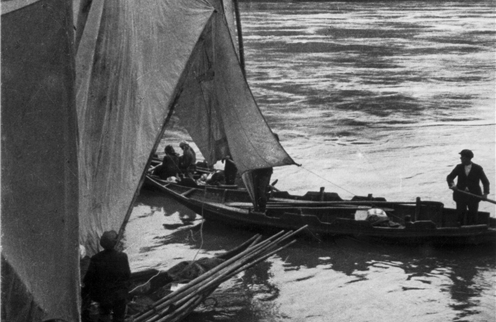Quem decide o que é um clássico? O que é um clássico? Um clássico pode deixar de ser clássico? Existem clássicos contemporâneos? Em que momento é que o contemporâneo se torna clássico? Os clássicos nascem clássicos ou tornam-se clássicos? O que faz de uma obra um clássico? Existem receitas para fazer clássicos? Há estilos de clássico? O clássico é acessível? Existem maus clássicos? Podem os meus clássicos nada ter de clássico?
Só tenho um critério: sei que amarei sempre os clássicos. Clássico é tudo o que amo hoje como amei ontem, sabendo que amanhã o amarei também. Os clássicos não têm idade, nunca envelhecem. Amar os clássicos não é ser retrógrado ou demodé, é querer parar o tempo e pará-lo 'de facto', é ser eternamente jovem mesmo que não se seja ou não se queira ser jovem, é uma forma de moldar o tempo e incluir todos os tempos num eterno presente.
Aniki-Bobó, Manoel de Oliveira, 1942.
Douro, Faina Fluvial, Manoel de Oliveira, 1931.
Anna May Wong.
Anna May Wong, Dangerous to Know.
Limehouse Blues (East End Chant), directed by Alexander Hall, 1934.
«It's "Never the twain shall meet" time again, this time in London's Limehouse district. George Raft stars as Harry Young, a half-caste saloonkeeper who shelters beleaguered white girl Toni (Jean Parker) from her tormentors (shades of Broken Blossoms). Harry falls in love with the girl, but mixing of the races was still a Hollywood no-no in 1934, so tragedy results -- except for Toni, who finds happiness in the arms of Eric Benton (Kent Taylor), a man of "her own kind." The highly eclectic cast includes Anna May Wong as Raft's obligatory cast-off sweetheart Tu Tuan, former 2-reel comic Billy Bevan, and in a tiny uncredited role, Ann Sheridan. To avoid confusion with another Limehouse Blues, this one was retitled East End Chant for television.»
(November 26, 1922), Anna May Wong as Lotus Flower.
From the Wikipedia entry for "The Toll of the Sea":
«The Toll of the Sea is a 1922 American motion picture, directed by Chester M. Franklin, produced by the Technicolor Motion Picture Corporation, and released by Metro Pictures in 1922, featuring Anna May Wong in her first leading role. It was the eighth color feature film, the second Technicolor feature, the first color feature made in Hollywood, and the first color feature anywhere that did not require a special projector to be shown. The original camera negative survives except for the final 2 reels. In 1985 the UCLA Film and Television Archive preserved the film from the original 35 mm nitrate negative. Because modern film technology was used to create a color print instead of the original Technicolor Process 2, which involved cementing together two film strips base to base, the resulting image quality is likely better than the original prints appeared.»Fonte: The Toll of the Sea
The Thief of Bagdad, with Douglas Fairbanks and Anna May Wong, 1924.
«The Thief of Bagdad is a 1924 American swashbuckler film directed by Raoul Walsh and starring Douglas Fairbanks. Freely adapted from One Thousand and One Nights, it tells the story of a thief who falls in love with the daughter of the Caliph of Bagdad. In 1996, the film was selected for preservation in the United States National Film Registry by the Library of Congress as being "culturally, historically, or aesthetically significant". [1]
Fairbanks considered this to be his personal favorite of all of his films, according to his son. The film's use of imaginative gymnastics fit the athletic star, his "catlike, seemingly effortless" movements were as much dance as gymnastics.[2] Along with his earlier Robin Hood (1922), the film marked Fairbanks's transformation from genial comedy to a career in "swashbuckling" roles.[3] The movie, strong on special effects of the period (flying carpet, magic rope and fearsome monsters) and featuring massive Arabian-style sets, also proved to be a stepping stone for Anna May Wong, who portrayed a treacherous Mongol slave.»
Fonte: ThiefOfBagdad1924
Tirez sur le pianiste / Shoot the Piano Player / Disparem Sobre o PIanista, 1960,
produção e realização de François Truffaut.
«Charlie Kohler is a piano player in a bar. The waitress Lena is in love with him. One of Charlie's brother, Chico, a crook, takes refuge in the bar because he is chased by two gangsters, Momo and Ernest. We will discover that Charlie's real name is Edouard Saroyan, once a virtuose who gives up after his wife's suicide.»
Fontes:
Tirez sur le pianiste / Shoot the Piano Player / Disparem Sobre o Pianista, François Truffaut. Charles Aznavour, o pianista.
Tirez sur le pianiste / Shoot the Piano Player / Disparem Sobre o PIanista,1960,
produção e realização de François Truffaut.
Les quatre cents coups / The 400 Blows / Os Quatrocentos Golpes,
François Truffaut, 1959.
Child Bride, 1938.Director: Harry Revier; Producer: Kroger Babb.
«Schoolteacher in a rural community campaigns to stop the practice of older men
marrying young, underage girls.»
Fonte: Internet Archive - Feature Films







Sem comentários:
Enviar um comentário